
USS Trenton (LPD-14), an Austin-class amphibious transport dock, was the third ship of the United States Navy to be named for the capital of New Jersey. In 2007, it was sold to the Indian Navy and renamed INS Jalashwa.
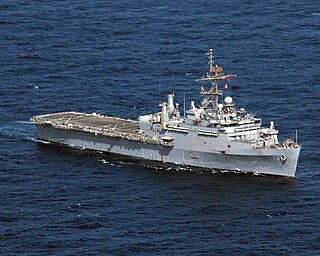
USS Nashville (LPD-13), was an Austin-class amphibious transport dock and the third ship of the United States Navy to be named for the capital city of Tennessee. Her keel was laid down on 14 March 1966 by the Lockheed Shipbuilding and Construction Company of Seattle, Washington. She was launched on 7 October 1967 sponsored by Mrs. Roy L. Johnson, and commissioned at Puget Sound Naval Shipyard, Bremerton, Washington, on 14 February 1970.

The Sixth Fleet is a numbered fleet of the United States Navy operating as part of United States Naval Forces Europe-Africa. The Sixth Fleet is headquartered at Naval Support Activity Naples, Italy. The officially stated mission of the Sixth Fleet in 2011 is that it "conducts the full range of Maritime Operations and Theater Security Cooperation missions, in concert with coalition, joint, interagency, and other parties, in order to advance security and stability in Europe and Africa." The current commander of the Sixth Fleet is Vice Admiral Thomas E. Ishee.

USS Biddle/Claude V. Ricketts (DD-995/DDG-5), was a Charles F. Adams-class guided missile destroyer of the United States Navy. She was the third US Naval ship named after Nicholas Biddle, one of the first five captains of the Continental Navy.

USS Conyngham (DDG-17), the third ship named for Captain Gustavus Conyngham USN (1744–1819), was a Charles F. Adams-class guided missile armed destroyer in the United States Navy.

USS Iwo Jima (LHD-7) is a Wasp-class amphibious assault ship of the United States Navy. The ship was named for the Battle of Iwo Jima of World War II. The ship was commissioned in 2001 and is in service.

USS Iwo Jima (LPH-2) was the lead ship of her class and type and the first amphibious assault ship to be designed and built from the keel up as a dedicated helicopter carrier. She carried helicopters and typically embarked USMC elements of a Marine Amphibious Unit (MAU)/later Marine Expeditionary Unit (MEU) principally the Aviation Combat Element (ACE) to conduct heliborne operations in support of an amphibious operation. There was no well deck to support landing craft movement of personnel or equipment to/from shore. Iwo Jima was the second of three ships of the United States Navy to be named for the Battle of Iwo Jima, although the first to be completed and see service.

USS Guam (LPH-9), was an Iwo Jima-class amphibious assault ship, and was laid down by the Philadelphia Naval Shipyard on 15 November 1962; launched on 22 August 1964, sponsored by Mrs. Vaughn H. Emory Green, and commissioned on 16 January 1965. She was the third US Navy ship to carry the name, after the US Territory of Guam.

Strike Fighter Squadron 86 (VFA-86) is a strike fighter squadron of the United States Navy based at Naval Air Station Lemoore, California. The squadron is nicknamed Sidewinders, leading to the call sign Winder. The unit is currently in transition to the F-35C Lightning II and is not assigned to a Carrier Air Wing at this time.
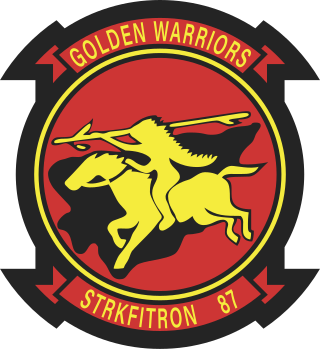
The Strike Fighter Squadron 87 (VFA-87) is a United States Navy strike fighter squadron based at Naval Air Station Oceana. The squadron is equipped with the Boeing F/A-18E Super Hornet and is nicknamed the Golden Warriors, its call sign is War Party. Currently, the squadron is assigned to Carrier Air Wing 8.
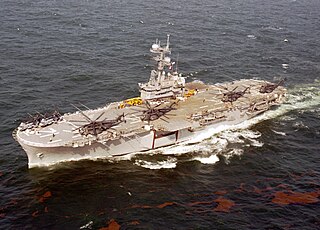
USS Inchon (LPH/MCS-12) was an Iwo Jima-class amphibious assault ship of the United States Navy in service from 1970 to 2002. Following a major fire, she was laid up and sunk as a target in 2004.

USS Fort Snelling (LSD-30) was a Thomaston-class dock landing ship of the United States Navy. She was named for Fort Snelling at the confluence of the Minnesota and Mississippi Rivers, for many years the northernmost military post in the land of the Sioux and Chippewa. She was the second ship assigned that name, but the construction of Fort Snelling (LSD-23) was canceled on 17 August 1945.
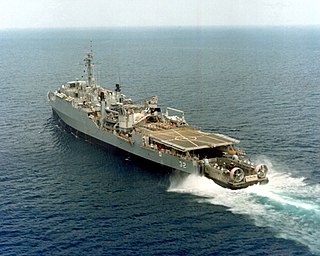
USS Spiegel Grove (LSD-32) was a Thomaston-class dock landing ship of the United States Navy. She was named for Spiegel Grove, the home and estate in Fremont, Ohio, of Rutherford B. Hayes, the 19th President of the United States.

Electromagnetic Attack Squadron 137 (VAQ-137) also known as the "Rooks", is a United States Navy electromagnetic attack squadron based at Naval Air Station Whidbey Island Washington, flying the Boeing EA-18G Growler. The squadron is attached to Carrier Air Wing 11 (CVW-11), which is currently assigned to USS Theodore Roosevelt (CVN-71). Their radio callsign is "Rook" and their tailcode is "NH" of CVW-11.
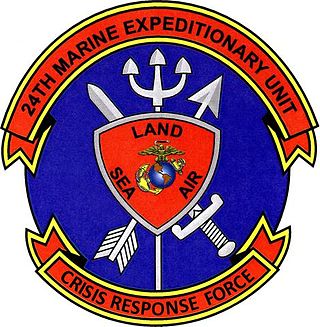
The 24th Marine Expeditionary Unit is one of seven Marine Expeditionary Units currently in existence in the United States Marine Corps. The Marine Expeditionary Unit is a Marine Air Ground Task Force (MAGTF) with a strength of about 2,200 personnel. The MEU consists of a Command Element, a Ground Combat Element based on a reinforced infantry battalion, an Aviation Combat Element based on a reinforced tiltrotor squadron, and a Logistics Command Element based on a Combat Logistics Battalion. The 24th MEU is currently based out of Marine Corps Base Camp Lejeune, North Carolina.
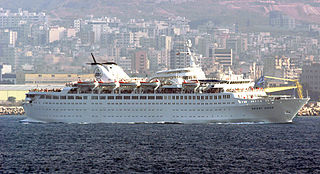
The MS Starward was a cruise ship built in 1968 at the AG Weser shipyard in Bremerhaven, West Germany. Originally commissioned for Norwegian Caribbean Line after the success of its first ship, Sunward, Starward was the first purpose-built ship for the newly-established cruise line. In 1995, Starward was sold to Festival Cruises, which they renamed the vessel Bolero. The vessel was shortly chartered to Spanish Cruise Line, however, it was sold to Abou Merhi Cruises after Festival Cruises was forced to declare bankruptcy in early 2004. In 2006, Louis Cruise Lines bought Orient Queen and kept the name intact. Orient Queen was briefly used the United States Government in 2006 to evacuate U.S. citizens out of Lebanon due to conflict between Lebanon and Israel. Louis Cruise Lines renamed the ship to Louis Aura in 2012. In 2017, Etstur, a Turkish travel agency, chartered the ship and renamed it to Aegean Queen. She was sold to for scrap the following year, and was broken up in Alang, India.

USS Vreeland (FF-1068) was a Knox-class frigate of the United States Navy. The ship was named for Rear Admiral Charles E. Vreeland (1852–1916).

USS Hyades (AF-28) was the lead ship of her class of stores ships acquired by the U.S. Navy for service in World War II. Her task was to carry stores, refrigerated items, and equipment to ships in the fleet and to remote stations and staging areas.
The following is a timeline of the presidency of Gerald Ford from January 1, 1976, to January 20, 1977.

Operation Highbrow was a British Ministry of Defence (MoD) operation to evacuate civilians from Beirut as a result of the escalating 2006 Lebanon War. Initially, helicopters started ferrying the most vulnerable to Cyprus with several Royal Navy ships later transporting evacuees across the Mediterranean Sea to Cyprus. The operation involved Royal Navy surface ships and helicopters, with Royal Air Force helicopters also providing support and transit. The operation was described as being the largest evacuation that Britain was involved in since Dunkirk.



















